BUS8101: Research Proposal on Fast Food Purchasing Intention
VerifiedAdded on 2023/01/17
|22
|5801
|70
Project
AI Summary
This research proposal investigates the factors influencing consumer purchasing intentions within the fast food industry in New Zealand. It examines the impact of service quality, food quality, and the physical environment of fast-food restaurants on customer behavior, with perceived value acting as a mediator and perceived price as a moderator. The study aims to analyze industry trends, identify opportunities and threats, and provide recommendations for improving consumer purchasing intentions. The research will employ both primary and secondary data collection methods, using a quantitative approach to analyze the relationships between variables. The expected outcome is to provide insights that will help fast-food restaurants understand and prioritize the key elements that affect consumer decisions, ultimately leading to improved business growth and profitability.
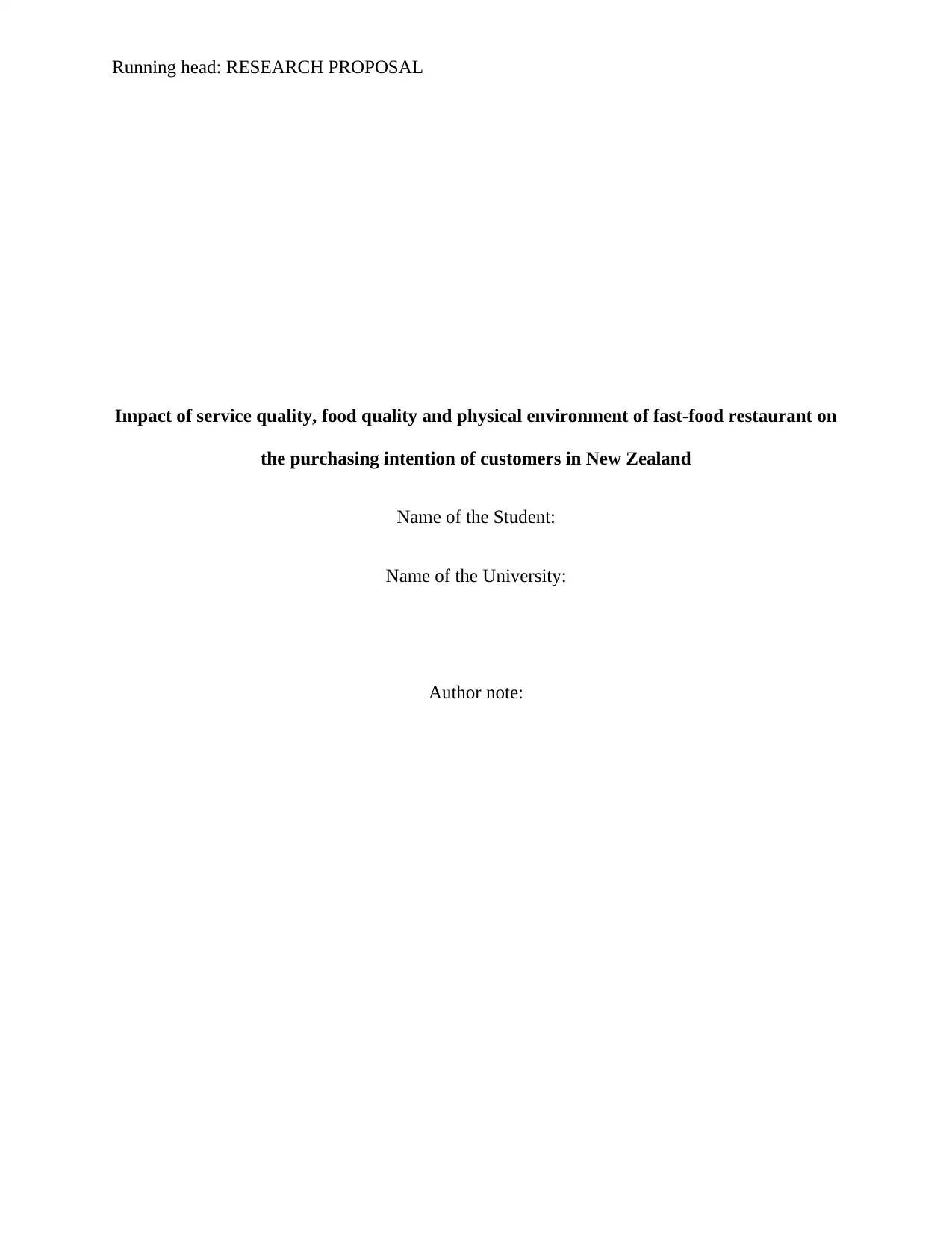
Running head: RESEARCH PROPOSAL
Impact of service quality, food quality and physical environment of fast-food restaurant on
the purchasing intention of customers in New Zealand
Name of the Student:
Name of the University:
Author note:
Impact of service quality, food quality and physical environment of fast-food restaurant on
the purchasing intention of customers in New Zealand
Name of the Student:
Name of the University:
Author note:
Paraphrase This Document
Need a fresh take? Get an instant paraphrase of this document with our AI Paraphraser
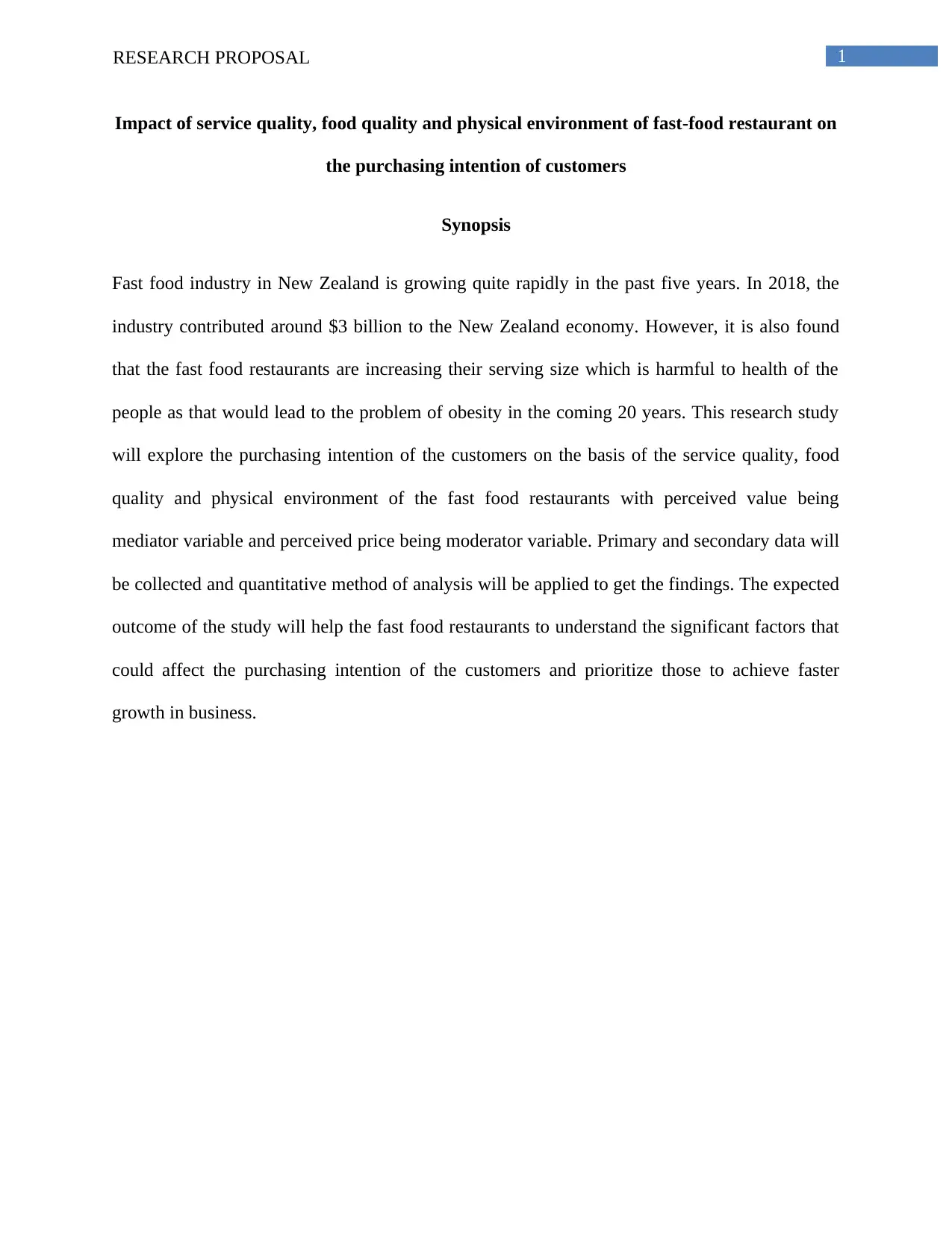
1RESEARCH PROPOSAL
Impact of service quality, food quality and physical environment of fast-food restaurant on
the purchasing intention of customers
Synopsis
Fast food industry in New Zealand is growing quite rapidly in the past five years. In 2018, the
industry contributed around $3 billion to the New Zealand economy. However, it is also found
that the fast food restaurants are increasing their serving size which is harmful to health of the
people as that would lead to the problem of obesity in the coming 20 years. This research study
will explore the purchasing intention of the customers on the basis of the service quality, food
quality and physical environment of the fast food restaurants with perceived value being
mediator variable and perceived price being moderator variable. Primary and secondary data will
be collected and quantitative method of analysis will be applied to get the findings. The expected
outcome of the study will help the fast food restaurants to understand the significant factors that
could affect the purchasing intention of the customers and prioritize those to achieve faster
growth in business.
Impact of service quality, food quality and physical environment of fast-food restaurant on
the purchasing intention of customers
Synopsis
Fast food industry in New Zealand is growing quite rapidly in the past five years. In 2018, the
industry contributed around $3 billion to the New Zealand economy. However, it is also found
that the fast food restaurants are increasing their serving size which is harmful to health of the
people as that would lead to the problem of obesity in the coming 20 years. This research study
will explore the purchasing intention of the customers on the basis of the service quality, food
quality and physical environment of the fast food restaurants with perceived value being
mediator variable and perceived price being moderator variable. Primary and secondary data will
be collected and quantitative method of analysis will be applied to get the findings. The expected
outcome of the study will help the fast food restaurants to understand the significant factors that
could affect the purchasing intention of the customers and prioritize those to achieve faster
growth in business.
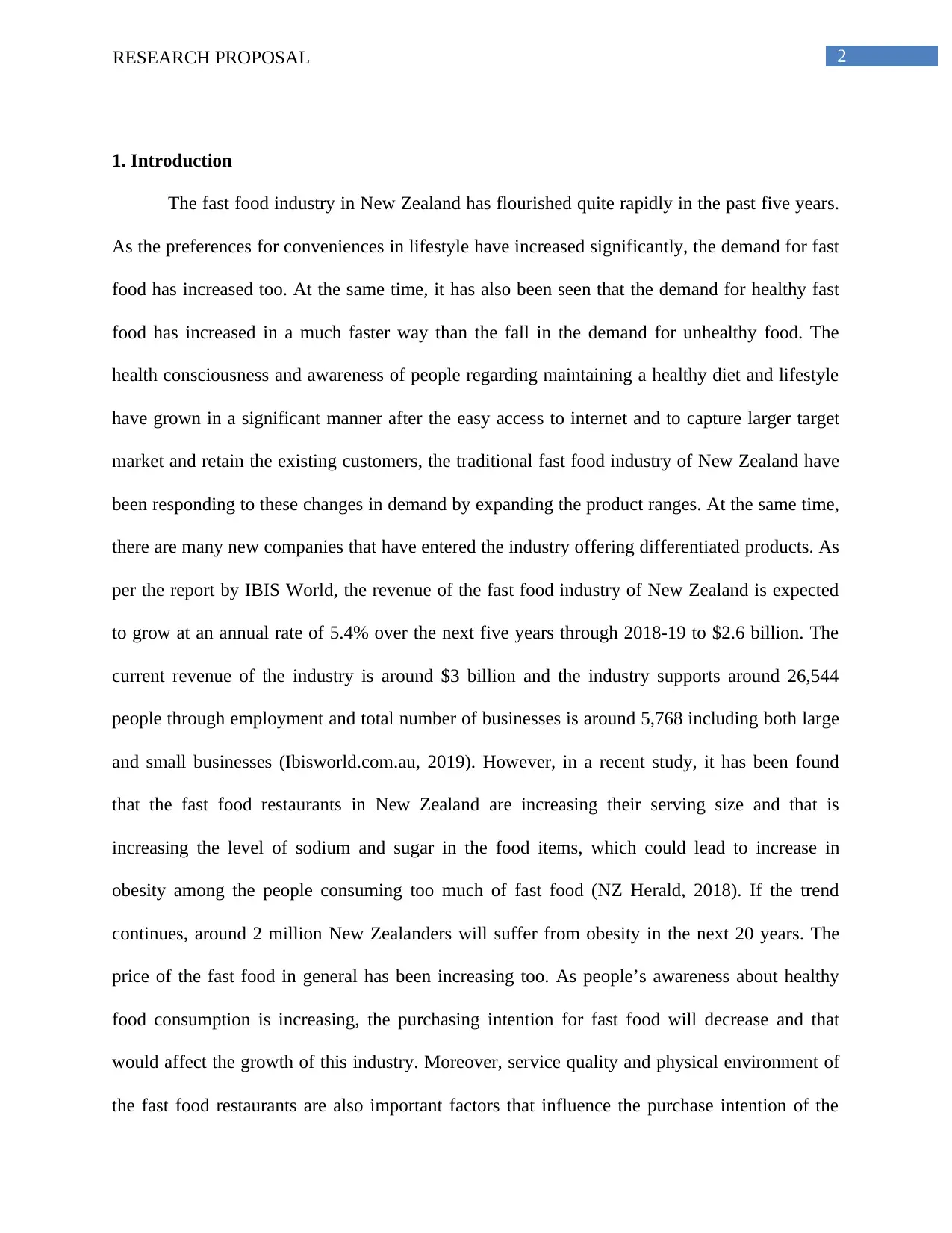
2RESEARCH PROPOSAL
1. Introduction
The fast food industry in New Zealand has flourished quite rapidly in the past five years.
As the preferences for conveniences in lifestyle have increased significantly, the demand for fast
food has increased too. At the same time, it has also been seen that the demand for healthy fast
food has increased in a much faster way than the fall in the demand for unhealthy food. The
health consciousness and awareness of people regarding maintaining a healthy diet and lifestyle
have grown in a significant manner after the easy access to internet and to capture larger target
market and retain the existing customers, the traditional fast food industry of New Zealand have
been responding to these changes in demand by expanding the product ranges. At the same time,
there are many new companies that have entered the industry offering differentiated products. As
per the report by IBIS World, the revenue of the fast food industry of New Zealand is expected
to grow at an annual rate of 5.4% over the next five years through 2018-19 to $2.6 billion. The
current revenue of the industry is around $3 billion and the industry supports around 26,544
people through employment and total number of businesses is around 5,768 including both large
and small businesses (Ibisworld.com.au, 2019). However, in a recent study, it has been found
that the fast food restaurants in New Zealand are increasing their serving size and that is
increasing the level of sodium and sugar in the food items, which could lead to increase in
obesity among the people consuming too much of fast food (NZ Herald, 2018). If the trend
continues, around 2 million New Zealanders will suffer from obesity in the next 20 years. The
price of the fast food in general has been increasing too. As people’s awareness about healthy
food consumption is increasing, the purchasing intention for fast food will decrease and that
would affect the growth of this industry. Moreover, service quality and physical environment of
the fast food restaurants are also important factors that influence the purchase intention of the
1. Introduction
The fast food industry in New Zealand has flourished quite rapidly in the past five years.
As the preferences for conveniences in lifestyle have increased significantly, the demand for fast
food has increased too. At the same time, it has also been seen that the demand for healthy fast
food has increased in a much faster way than the fall in the demand for unhealthy food. The
health consciousness and awareness of people regarding maintaining a healthy diet and lifestyle
have grown in a significant manner after the easy access to internet and to capture larger target
market and retain the existing customers, the traditional fast food industry of New Zealand have
been responding to these changes in demand by expanding the product ranges. At the same time,
there are many new companies that have entered the industry offering differentiated products. As
per the report by IBIS World, the revenue of the fast food industry of New Zealand is expected
to grow at an annual rate of 5.4% over the next five years through 2018-19 to $2.6 billion. The
current revenue of the industry is around $3 billion and the industry supports around 26,544
people through employment and total number of businesses is around 5,768 including both large
and small businesses (Ibisworld.com.au, 2019). However, in a recent study, it has been found
that the fast food restaurants in New Zealand are increasing their serving size and that is
increasing the level of sodium and sugar in the food items, which could lead to increase in
obesity among the people consuming too much of fast food (NZ Herald, 2018). If the trend
continues, around 2 million New Zealanders will suffer from obesity in the next 20 years. The
price of the fast food in general has been increasing too. As people’s awareness about healthy
food consumption is increasing, the purchasing intention for fast food will decrease and that
would affect the growth of this industry. Moreover, service quality and physical environment of
the fast food restaurants are also important factors that influence the purchase intention of the
⊘ This is a preview!⊘
Do you want full access?
Subscribe today to unlock all pages.

Trusted by 1+ million students worldwide
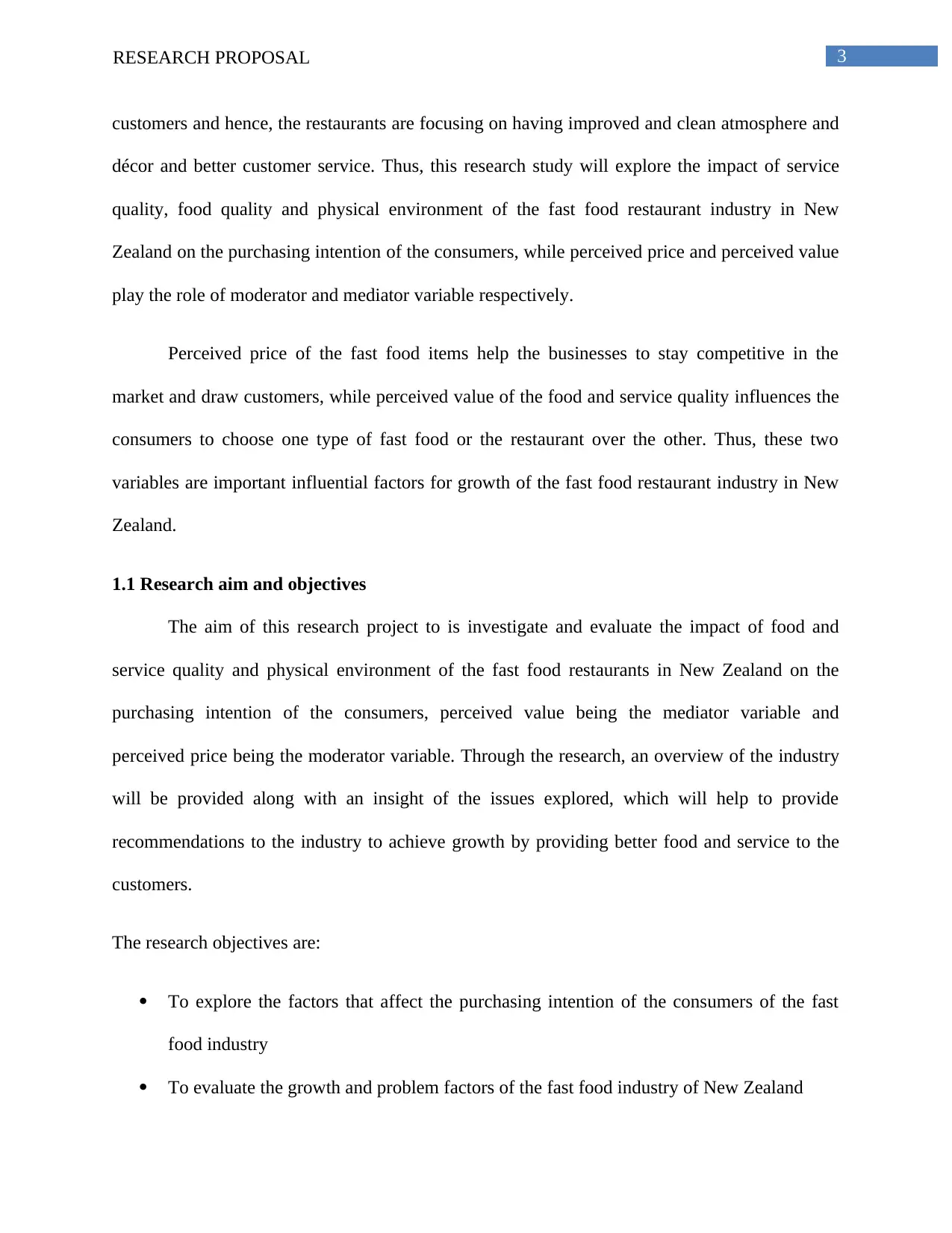
3RESEARCH PROPOSAL
customers and hence, the restaurants are focusing on having improved and clean atmosphere and
décor and better customer service. Thus, this research study will explore the impact of service
quality, food quality and physical environment of the fast food restaurant industry in New
Zealand on the purchasing intention of the consumers, while perceived price and perceived value
play the role of moderator and mediator variable respectively.
Perceived price of the fast food items help the businesses to stay competitive in the
market and draw customers, while perceived value of the food and service quality influences the
consumers to choose one type of fast food or the restaurant over the other. Thus, these two
variables are important influential factors for growth of the fast food restaurant industry in New
Zealand.
1.1 Research aim and objectives
The aim of this research project to is investigate and evaluate the impact of food and
service quality and physical environment of the fast food restaurants in New Zealand on the
purchasing intention of the consumers, perceived value being the mediator variable and
perceived price being the moderator variable. Through the research, an overview of the industry
will be provided along with an insight of the issues explored, which will help to provide
recommendations to the industry to achieve growth by providing better food and service to the
customers.
The research objectives are:
To explore the factors that affect the purchasing intention of the consumers of the fast
food industry
To evaluate the growth and problem factors of the fast food industry of New Zealand
customers and hence, the restaurants are focusing on having improved and clean atmosphere and
décor and better customer service. Thus, this research study will explore the impact of service
quality, food quality and physical environment of the fast food restaurant industry in New
Zealand on the purchasing intention of the consumers, while perceived price and perceived value
play the role of moderator and mediator variable respectively.
Perceived price of the fast food items help the businesses to stay competitive in the
market and draw customers, while perceived value of the food and service quality influences the
consumers to choose one type of fast food or the restaurant over the other. Thus, these two
variables are important influential factors for growth of the fast food restaurant industry in New
Zealand.
1.1 Research aim and objectives
The aim of this research project to is investigate and evaluate the impact of food and
service quality and physical environment of the fast food restaurants in New Zealand on the
purchasing intention of the consumers, perceived value being the mediator variable and
perceived price being the moderator variable. Through the research, an overview of the industry
will be provided along with an insight of the issues explored, which will help to provide
recommendations to the industry to achieve growth by providing better food and service to the
customers.
The research objectives are:
To explore the factors that affect the purchasing intention of the consumers of the fast
food industry
To evaluate the growth and problem factors of the fast food industry of New Zealand
Paraphrase This Document
Need a fresh take? Get an instant paraphrase of this document with our AI Paraphraser
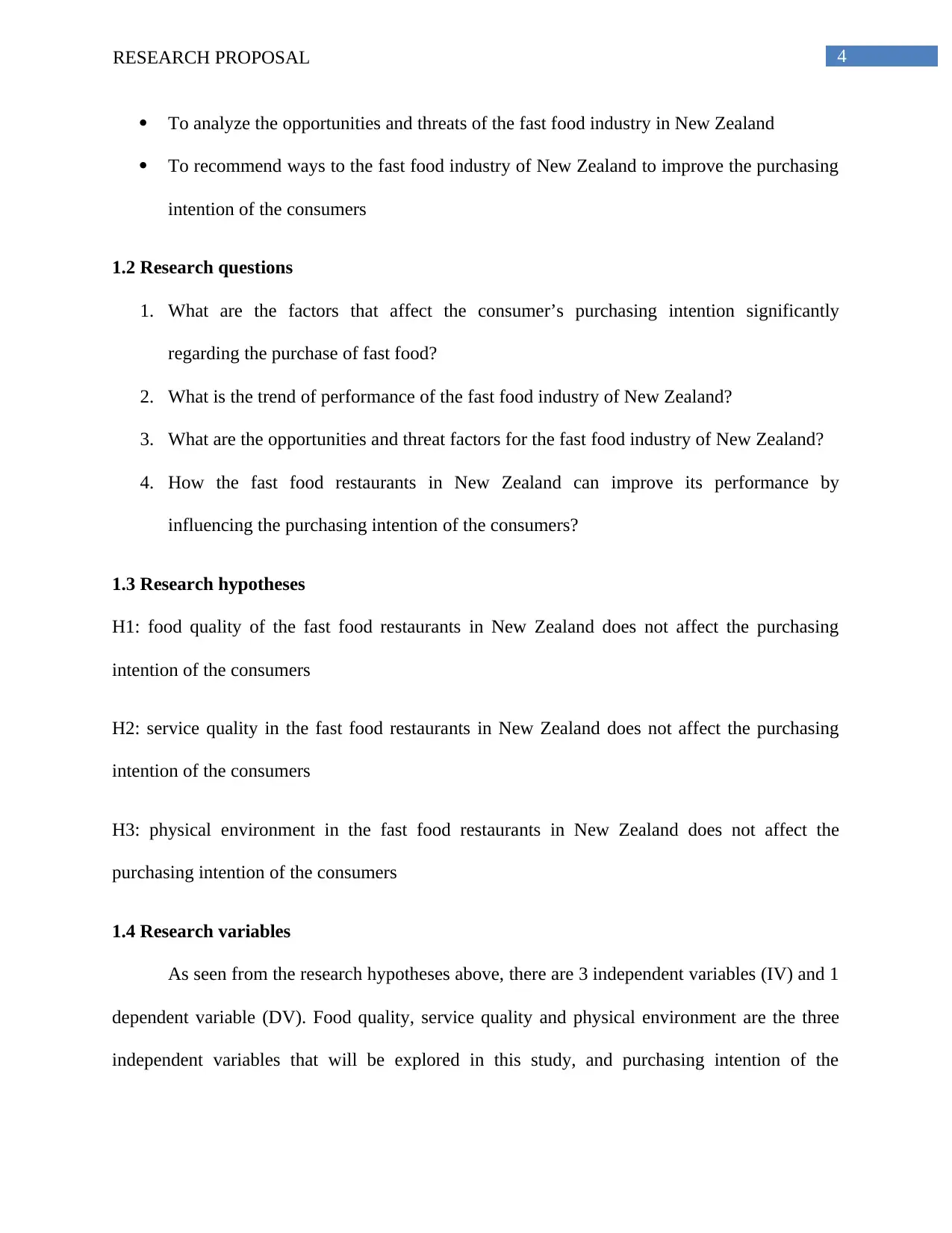
4RESEARCH PROPOSAL
To analyze the opportunities and threats of the fast food industry in New Zealand
To recommend ways to the fast food industry of New Zealand to improve the purchasing
intention of the consumers
1.2 Research questions
1. What are the factors that affect the consumer’s purchasing intention significantly
regarding the purchase of fast food?
2. What is the trend of performance of the fast food industry of New Zealand?
3. What are the opportunities and threat factors for the fast food industry of New Zealand?
4. How the fast food restaurants in New Zealand can improve its performance by
influencing the purchasing intention of the consumers?
1.3 Research hypotheses
H1: food quality of the fast food restaurants in New Zealand does not affect the purchasing
intention of the consumers
H2: service quality in the fast food restaurants in New Zealand does not affect the purchasing
intention of the consumers
H3: physical environment in the fast food restaurants in New Zealand does not affect the
purchasing intention of the consumers
1.4 Research variables
As seen from the research hypotheses above, there are 3 independent variables (IV) and 1
dependent variable (DV). Food quality, service quality and physical environment are the three
independent variables that will be explored in this study, and purchasing intention of the
To analyze the opportunities and threats of the fast food industry in New Zealand
To recommend ways to the fast food industry of New Zealand to improve the purchasing
intention of the consumers
1.2 Research questions
1. What are the factors that affect the consumer’s purchasing intention significantly
regarding the purchase of fast food?
2. What is the trend of performance of the fast food industry of New Zealand?
3. What are the opportunities and threat factors for the fast food industry of New Zealand?
4. How the fast food restaurants in New Zealand can improve its performance by
influencing the purchasing intention of the consumers?
1.3 Research hypotheses
H1: food quality of the fast food restaurants in New Zealand does not affect the purchasing
intention of the consumers
H2: service quality in the fast food restaurants in New Zealand does not affect the purchasing
intention of the consumers
H3: physical environment in the fast food restaurants in New Zealand does not affect the
purchasing intention of the consumers
1.4 Research variables
As seen from the research hypotheses above, there are 3 independent variables (IV) and 1
dependent variable (DV). Food quality, service quality and physical environment are the three
independent variables that will be explored in this study, and purchasing intention of the
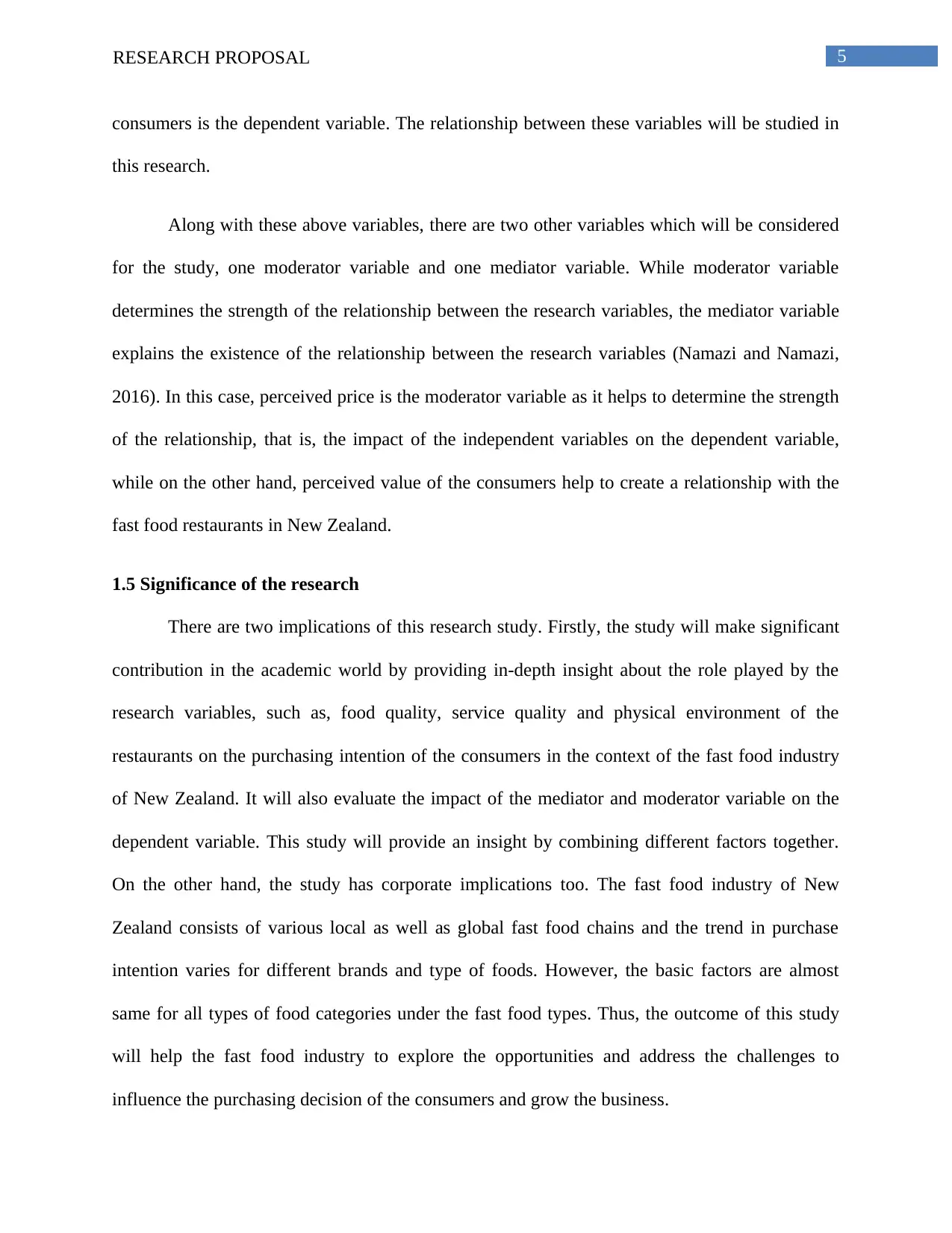
5RESEARCH PROPOSAL
consumers is the dependent variable. The relationship between these variables will be studied in
this research.
Along with these above variables, there are two other variables which will be considered
for the study, one moderator variable and one mediator variable. While moderator variable
determines the strength of the relationship between the research variables, the mediator variable
explains the existence of the relationship between the research variables (Namazi and Namazi,
2016). In this case, perceived price is the moderator variable as it helps to determine the strength
of the relationship, that is, the impact of the independent variables on the dependent variable,
while on the other hand, perceived value of the consumers help to create a relationship with the
fast food restaurants in New Zealand.
1.5 Significance of the research
There are two implications of this research study. Firstly, the study will make significant
contribution in the academic world by providing in-depth insight about the role played by the
research variables, such as, food quality, service quality and physical environment of the
restaurants on the purchasing intention of the consumers in the context of the fast food industry
of New Zealand. It will also evaluate the impact of the mediator and moderator variable on the
dependent variable. This study will provide an insight by combining different factors together.
On the other hand, the study has corporate implications too. The fast food industry of New
Zealand consists of various local as well as global fast food chains and the trend in purchase
intention varies for different brands and type of foods. However, the basic factors are almost
same for all types of food categories under the fast food types. Thus, the outcome of this study
will help the fast food industry to explore the opportunities and address the challenges to
influence the purchasing decision of the consumers and grow the business.
consumers is the dependent variable. The relationship between these variables will be studied in
this research.
Along with these above variables, there are two other variables which will be considered
for the study, one moderator variable and one mediator variable. While moderator variable
determines the strength of the relationship between the research variables, the mediator variable
explains the existence of the relationship between the research variables (Namazi and Namazi,
2016). In this case, perceived price is the moderator variable as it helps to determine the strength
of the relationship, that is, the impact of the independent variables on the dependent variable,
while on the other hand, perceived value of the consumers help to create a relationship with the
fast food restaurants in New Zealand.
1.5 Significance of the research
There are two implications of this research study. Firstly, the study will make significant
contribution in the academic world by providing in-depth insight about the role played by the
research variables, such as, food quality, service quality and physical environment of the
restaurants on the purchasing intention of the consumers in the context of the fast food industry
of New Zealand. It will also evaluate the impact of the mediator and moderator variable on the
dependent variable. This study will provide an insight by combining different factors together.
On the other hand, the study has corporate implications too. The fast food industry of New
Zealand consists of various local as well as global fast food chains and the trend in purchase
intention varies for different brands and type of foods. However, the basic factors are almost
same for all types of food categories under the fast food types. Thus, the outcome of this study
will help the fast food industry to explore the opportunities and address the challenges to
influence the purchasing decision of the consumers and grow the business.
⊘ This is a preview!⊘
Do you want full access?
Subscribe today to unlock all pages.

Trusted by 1+ million students worldwide
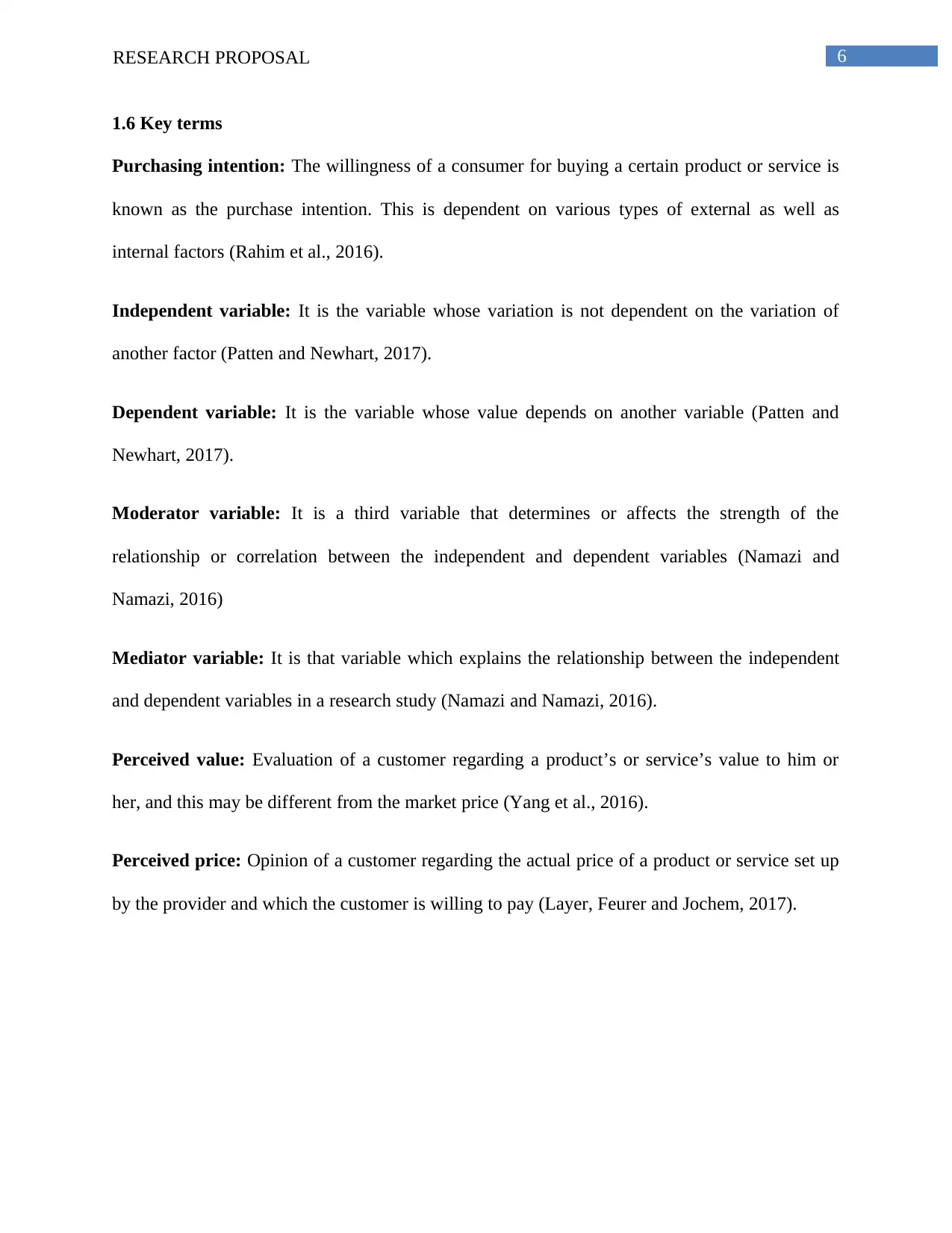
6RESEARCH PROPOSAL
1.6 Key terms
Purchasing intention: The willingness of a consumer for buying a certain product or service is
known as the purchase intention. This is dependent on various types of external as well as
internal factors (Rahim et al., 2016).
Independent variable: It is the variable whose variation is not dependent on the variation of
another factor (Patten and Newhart, 2017).
Dependent variable: It is the variable whose value depends on another variable (Patten and
Newhart, 2017).
Moderator variable: It is a third variable that determines or affects the strength of the
relationship or correlation between the independent and dependent variables (Namazi and
Namazi, 2016)
Mediator variable: It is that variable which explains the relationship between the independent
and dependent variables in a research study (Namazi and Namazi, 2016).
Perceived value: Evaluation of a customer regarding a product’s or service’s value to him or
her, and this may be different from the market price (Yang et al., 2016).
Perceived price: Opinion of a customer regarding the actual price of a product or service set up
by the provider and which the customer is willing to pay (Layer, Feurer and Jochem, 2017).
1.6 Key terms
Purchasing intention: The willingness of a consumer for buying a certain product or service is
known as the purchase intention. This is dependent on various types of external as well as
internal factors (Rahim et al., 2016).
Independent variable: It is the variable whose variation is not dependent on the variation of
another factor (Patten and Newhart, 2017).
Dependent variable: It is the variable whose value depends on another variable (Patten and
Newhart, 2017).
Moderator variable: It is a third variable that determines or affects the strength of the
relationship or correlation between the independent and dependent variables (Namazi and
Namazi, 2016)
Mediator variable: It is that variable which explains the relationship between the independent
and dependent variables in a research study (Namazi and Namazi, 2016).
Perceived value: Evaluation of a customer regarding a product’s or service’s value to him or
her, and this may be different from the market price (Yang et al., 2016).
Perceived price: Opinion of a customer regarding the actual price of a product or service set up
by the provider and which the customer is willing to pay (Layer, Feurer and Jochem, 2017).
Paraphrase This Document
Need a fresh take? Get an instant paraphrase of this document with our AI Paraphraser
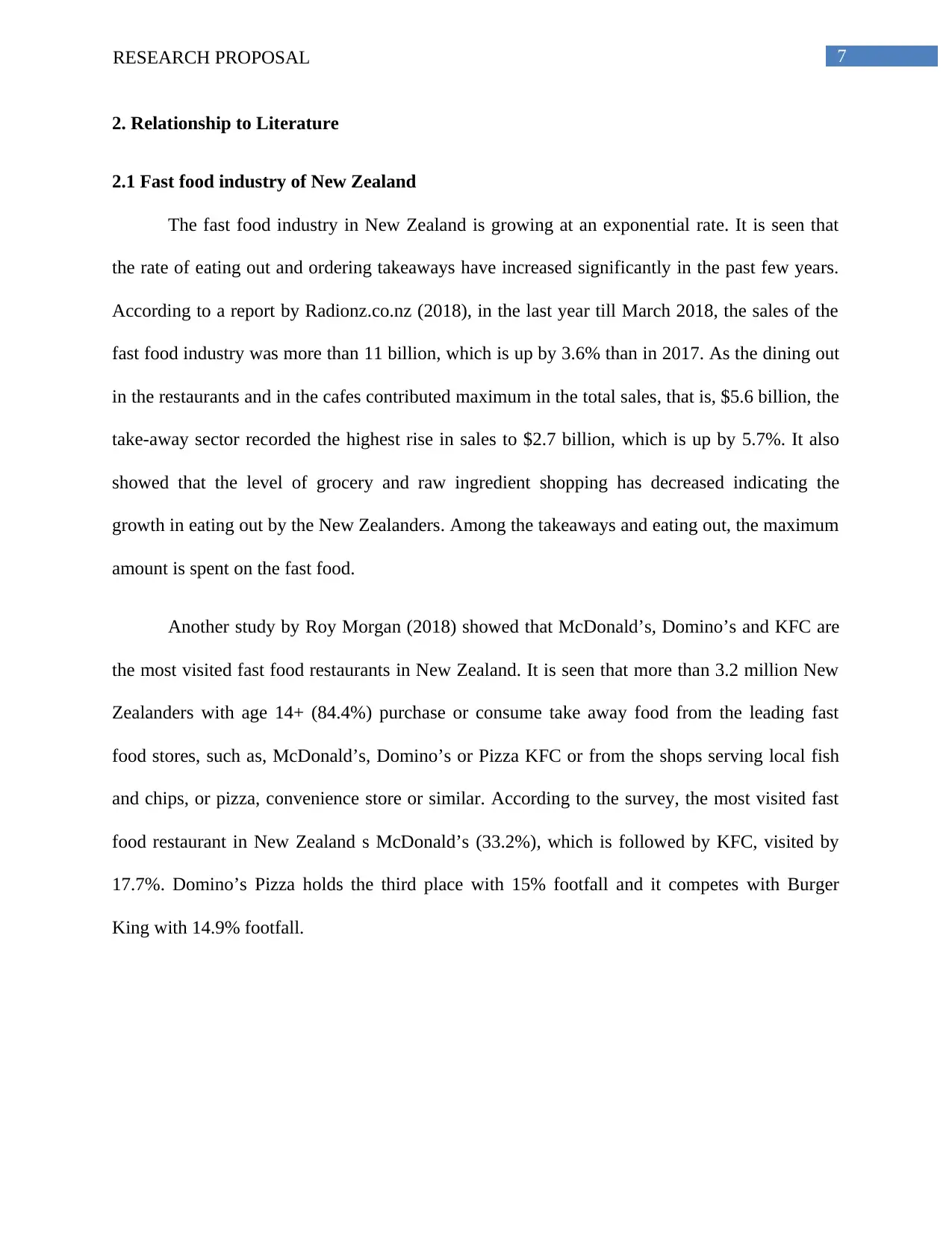
7RESEARCH PROPOSAL
2. Relationship to Literature
2.1 Fast food industry of New Zealand
The fast food industry in New Zealand is growing at an exponential rate. It is seen that
the rate of eating out and ordering takeaways have increased significantly in the past few years.
According to a report by Radionz.co.nz (2018), in the last year till March 2018, the sales of the
fast food industry was more than 11 billion, which is up by 3.6% than in 2017. As the dining out
in the restaurants and in the cafes contributed maximum in the total sales, that is, $5.6 billion, the
take-away sector recorded the highest rise in sales to $2.7 billion, which is up by 5.7%. It also
showed that the level of grocery and raw ingredient shopping has decreased indicating the
growth in eating out by the New Zealanders. Among the takeaways and eating out, the maximum
amount is spent on the fast food.
Another study by Roy Morgan (2018) showed that McDonald’s, Domino’s and KFC are
the most visited fast food restaurants in New Zealand. It is seen that more than 3.2 million New
Zealanders with age 14+ (84.4%) purchase or consume take away food from the leading fast
food stores, such as, McDonald’s, Domino’s or Pizza KFC or from the shops serving local fish
and chips, or pizza, convenience store or similar. According to the survey, the most visited fast
food restaurant in New Zealand s McDonald’s (33.2%), which is followed by KFC, visited by
17.7%. Domino’s Pizza holds the third place with 15% footfall and it competes with Burger
King with 14.9% footfall.
2. Relationship to Literature
2.1 Fast food industry of New Zealand
The fast food industry in New Zealand is growing at an exponential rate. It is seen that
the rate of eating out and ordering takeaways have increased significantly in the past few years.
According to a report by Radionz.co.nz (2018), in the last year till March 2018, the sales of the
fast food industry was more than 11 billion, which is up by 3.6% than in 2017. As the dining out
in the restaurants and in the cafes contributed maximum in the total sales, that is, $5.6 billion, the
take-away sector recorded the highest rise in sales to $2.7 billion, which is up by 5.7%. It also
showed that the level of grocery and raw ingredient shopping has decreased indicating the
growth in eating out by the New Zealanders. Among the takeaways and eating out, the maximum
amount is spent on the fast food.
Another study by Roy Morgan (2018) showed that McDonald’s, Domino’s and KFC are
the most visited fast food restaurants in New Zealand. It is seen that more than 3.2 million New
Zealanders with age 14+ (84.4%) purchase or consume take away food from the leading fast
food stores, such as, McDonald’s, Domino’s or Pizza KFC or from the shops serving local fish
and chips, or pizza, convenience store or similar. According to the survey, the most visited fast
food restaurant in New Zealand s McDonald’s (33.2%), which is followed by KFC, visited by
17.7%. Domino’s Pizza holds the third place with 15% footfall and it competes with Burger
King with 14.9% footfall.
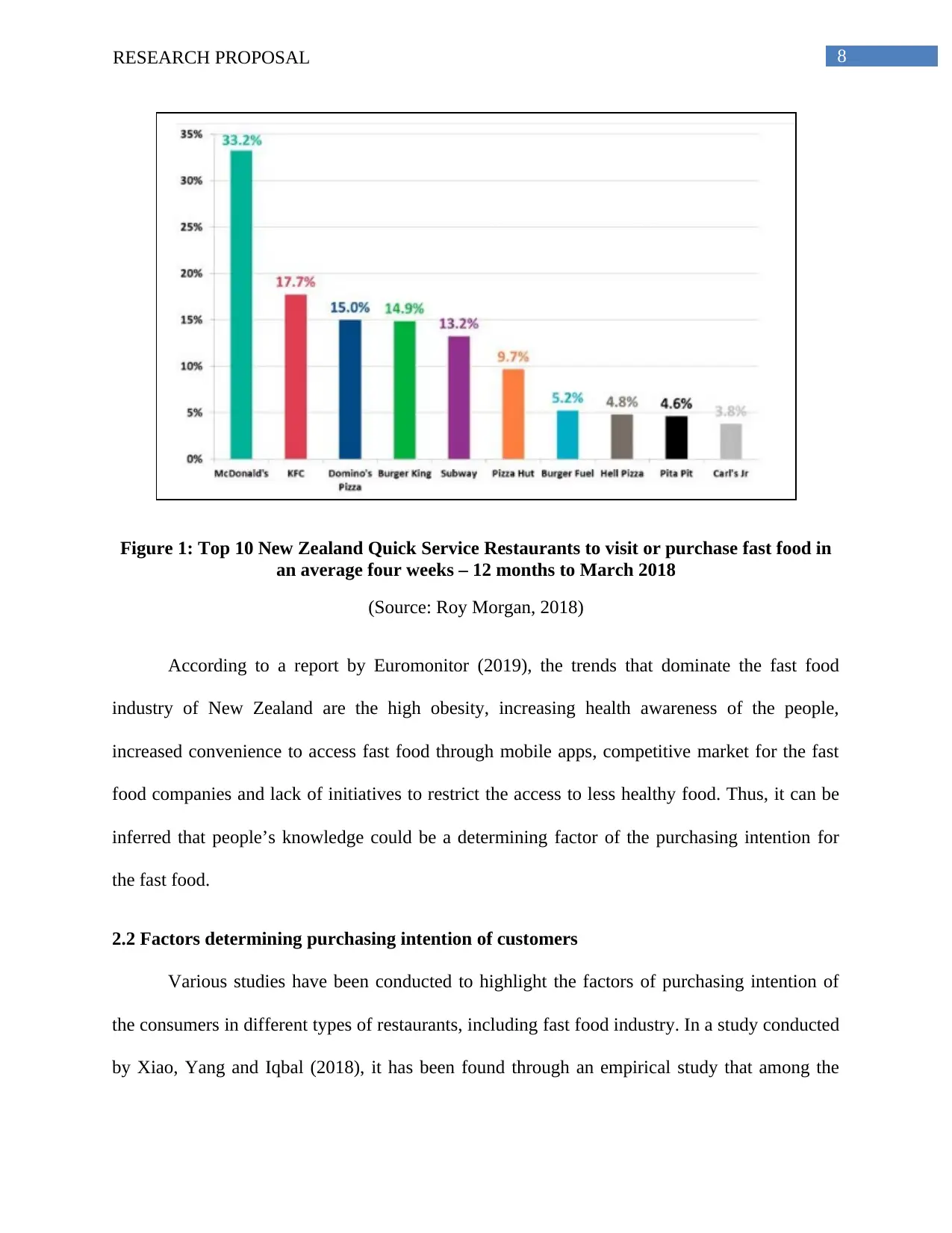
8RESEARCH PROPOSAL
Figure 1: Top 10 New Zealand Quick Service Restaurants to visit or purchase fast food in
an average four weeks – 12 months to March 2018
(Source: Roy Morgan, 2018)
According to a report by Euromonitor (2019), the trends that dominate the fast food
industry of New Zealand are the high obesity, increasing health awareness of the people,
increased convenience to access fast food through mobile apps, competitive market for the fast
food companies and lack of initiatives to restrict the access to less healthy food. Thus, it can be
inferred that people’s knowledge could be a determining factor of the purchasing intention for
the fast food.
2.2 Factors determining purchasing intention of customers
Various studies have been conducted to highlight the factors of purchasing intention of
the consumers in different types of restaurants, including fast food industry. In a study conducted
by Xiao, Yang and Iqbal (2018), it has been found through an empirical study that among the
Figure 1: Top 10 New Zealand Quick Service Restaurants to visit or purchase fast food in
an average four weeks – 12 months to March 2018
(Source: Roy Morgan, 2018)
According to a report by Euromonitor (2019), the trends that dominate the fast food
industry of New Zealand are the high obesity, increasing health awareness of the people,
increased convenience to access fast food through mobile apps, competitive market for the fast
food companies and lack of initiatives to restrict the access to less healthy food. Thus, it can be
inferred that people’s knowledge could be a determining factor of the purchasing intention for
the fast food.
2.2 Factors determining purchasing intention of customers
Various studies have been conducted to highlight the factors of purchasing intention of
the consumers in different types of restaurants, including fast food industry. In a study conducted
by Xiao, Yang and Iqbal (2018), it has been found through an empirical study that among the
⊘ This is a preview!⊘
Do you want full access?
Subscribe today to unlock all pages.

Trusted by 1+ million students worldwide
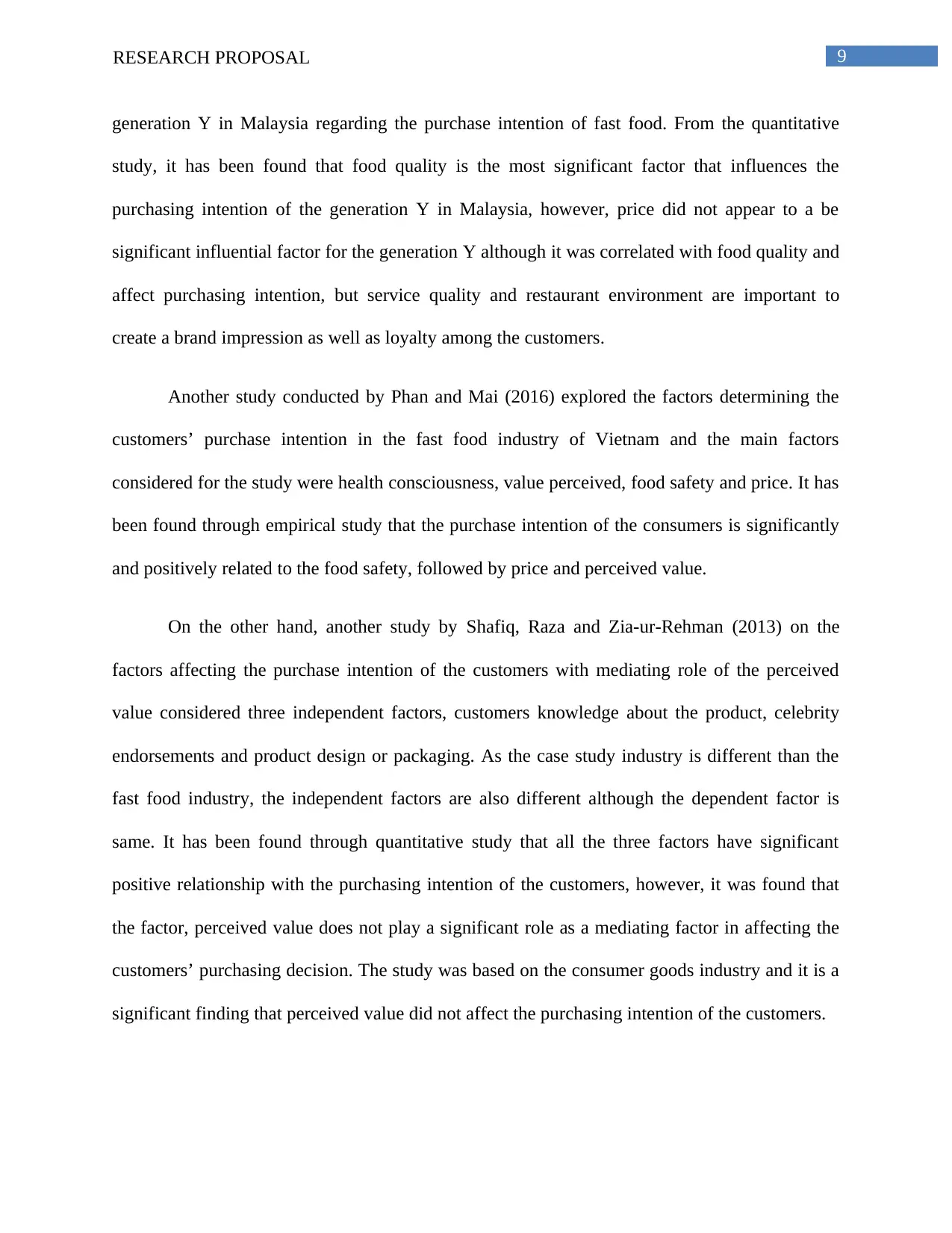
9RESEARCH PROPOSAL
generation Y in Malaysia regarding the purchase intention of fast food. From the quantitative
study, it has been found that food quality is the most significant factor that influences the
purchasing intention of the generation Y in Malaysia, however, price did not appear to a be
significant influential factor for the generation Y although it was correlated with food quality and
affect purchasing intention, but service quality and restaurant environment are important to
create a brand impression as well as loyalty among the customers.
Another study conducted by Phan and Mai (2016) explored the factors determining the
customers’ purchase intention in the fast food industry of Vietnam and the main factors
considered for the study were health consciousness, value perceived, food safety and price. It has
been found through empirical study that the purchase intention of the consumers is significantly
and positively related to the food safety, followed by price and perceived value.
On the other hand, another study by Shafiq, Raza and Zia-ur-Rehman (2013) on the
factors affecting the purchase intention of the customers with mediating role of the perceived
value considered three independent factors, customers knowledge about the product, celebrity
endorsements and product design or packaging. As the case study industry is different than the
fast food industry, the independent factors are also different although the dependent factor is
same. It has been found through quantitative study that all the three factors have significant
positive relationship with the purchasing intention of the customers, however, it was found that
the factor, perceived value does not play a significant role as a mediating factor in affecting the
customers’ purchasing decision. The study was based on the consumer goods industry and it is a
significant finding that perceived value did not affect the purchasing intention of the customers.
generation Y in Malaysia regarding the purchase intention of fast food. From the quantitative
study, it has been found that food quality is the most significant factor that influences the
purchasing intention of the generation Y in Malaysia, however, price did not appear to a be
significant influential factor for the generation Y although it was correlated with food quality and
affect purchasing intention, but service quality and restaurant environment are important to
create a brand impression as well as loyalty among the customers.
Another study conducted by Phan and Mai (2016) explored the factors determining the
customers’ purchase intention in the fast food industry of Vietnam and the main factors
considered for the study were health consciousness, value perceived, food safety and price. It has
been found through empirical study that the purchase intention of the consumers is significantly
and positively related to the food safety, followed by price and perceived value.
On the other hand, another study by Shafiq, Raza and Zia-ur-Rehman (2013) on the
factors affecting the purchase intention of the customers with mediating role of the perceived
value considered three independent factors, customers knowledge about the product, celebrity
endorsements and product design or packaging. As the case study industry is different than the
fast food industry, the independent factors are also different although the dependent factor is
same. It has been found through quantitative study that all the three factors have significant
positive relationship with the purchasing intention of the customers, however, it was found that
the factor, perceived value does not play a significant role as a mediating factor in affecting the
customers’ purchasing decision. The study was based on the consumer goods industry and it is a
significant finding that perceived value did not affect the purchasing intention of the customers.
Paraphrase This Document
Need a fresh take? Get an instant paraphrase of this document with our AI Paraphraser
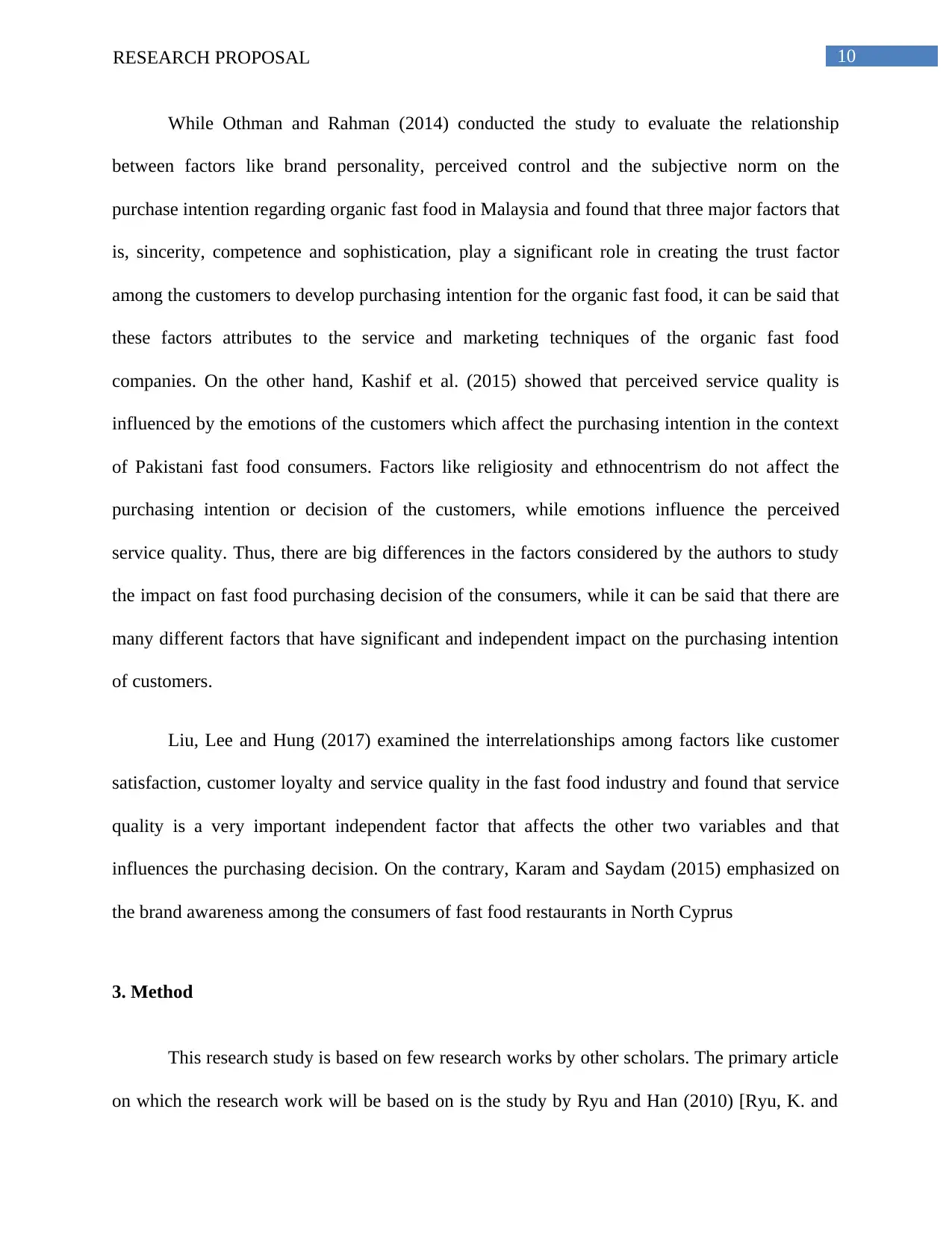
10RESEARCH PROPOSAL
While Othman and Rahman (2014) conducted the study to evaluate the relationship
between factors like brand personality, perceived control and the subjective norm on the
purchase intention regarding organic fast food in Malaysia and found that three major factors that
is, sincerity, competence and sophistication, play a significant role in creating the trust factor
among the customers to develop purchasing intention for the organic fast food, it can be said that
these factors attributes to the service and marketing techniques of the organic fast food
companies. On the other hand, Kashif et al. (2015) showed that perceived service quality is
influenced by the emotions of the customers which affect the purchasing intention in the context
of Pakistani fast food consumers. Factors like religiosity and ethnocentrism do not affect the
purchasing intention or decision of the customers, while emotions influence the perceived
service quality. Thus, there are big differences in the factors considered by the authors to study
the impact on fast food purchasing decision of the consumers, while it can be said that there are
many different factors that have significant and independent impact on the purchasing intention
of customers.
Liu, Lee and Hung (2017) examined the interrelationships among factors like customer
satisfaction, customer loyalty and service quality in the fast food industry and found that service
quality is a very important independent factor that affects the other two variables and that
influences the purchasing decision. On the contrary, Karam and Saydam (2015) emphasized on
the brand awareness among the consumers of fast food restaurants in North Cyprus
3. Method
This research study is based on few research works by other scholars. The primary article
on which the research work will be based on is the study by Ryu and Han (2010) [Ryu, K. and
While Othman and Rahman (2014) conducted the study to evaluate the relationship
between factors like brand personality, perceived control and the subjective norm on the
purchase intention regarding organic fast food in Malaysia and found that three major factors that
is, sincerity, competence and sophistication, play a significant role in creating the trust factor
among the customers to develop purchasing intention for the organic fast food, it can be said that
these factors attributes to the service and marketing techniques of the organic fast food
companies. On the other hand, Kashif et al. (2015) showed that perceived service quality is
influenced by the emotions of the customers which affect the purchasing intention in the context
of Pakistani fast food consumers. Factors like religiosity and ethnocentrism do not affect the
purchasing intention or decision of the customers, while emotions influence the perceived
service quality. Thus, there are big differences in the factors considered by the authors to study
the impact on fast food purchasing decision of the consumers, while it can be said that there are
many different factors that have significant and independent impact on the purchasing intention
of customers.
Liu, Lee and Hung (2017) examined the interrelationships among factors like customer
satisfaction, customer loyalty and service quality in the fast food industry and found that service
quality is a very important independent factor that affects the other two variables and that
influences the purchasing decision. On the contrary, Karam and Saydam (2015) emphasized on
the brand awareness among the consumers of fast food restaurants in North Cyprus
3. Method
This research study is based on few research works by other scholars. The primary article
on which the research work will be based on is the study by Ryu and Han (2010) [Ryu, K. and
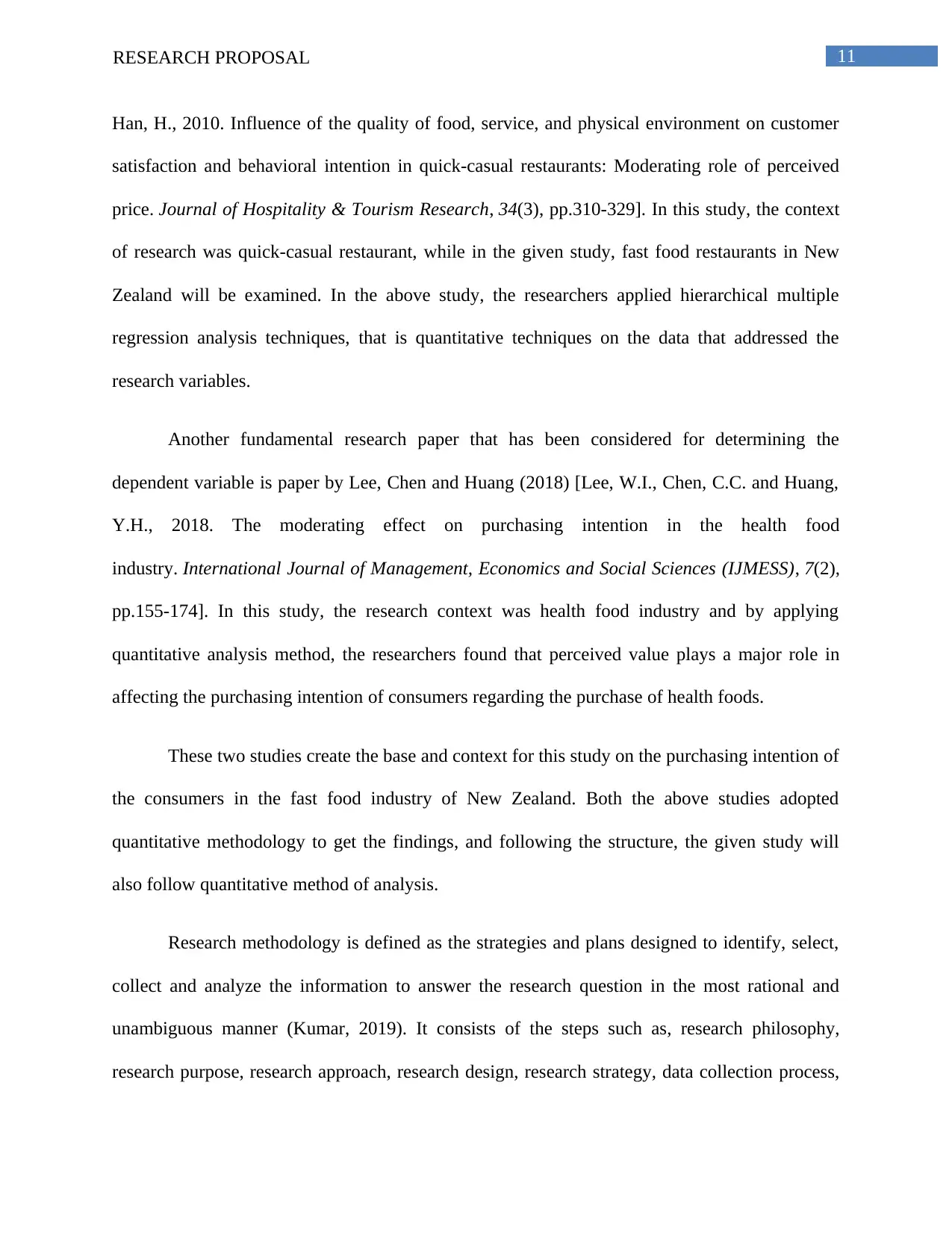
11RESEARCH PROPOSAL
Han, H., 2010. Influence of the quality of food, service, and physical environment on customer
satisfaction and behavioral intention in quick-casual restaurants: Moderating role of perceived
price. Journal of Hospitality & Tourism Research, 34(3), pp.310-329]. In this study, the context
of research was quick-casual restaurant, while in the given study, fast food restaurants in New
Zealand will be examined. In the above study, the researchers applied hierarchical multiple
regression analysis techniques, that is quantitative techniques on the data that addressed the
research variables.
Another fundamental research paper that has been considered for determining the
dependent variable is paper by Lee, Chen and Huang (2018) [Lee, W.I., Chen, C.C. and Huang,
Y.H., 2018. The moderating effect on purchasing intention in the health food
industry. International Journal of Management, Economics and Social Sciences (IJMESS), 7(2),
pp.155-174]. In this study, the research context was health food industry and by applying
quantitative analysis method, the researchers found that perceived value plays a major role in
affecting the purchasing intention of consumers regarding the purchase of health foods.
These two studies create the base and context for this study on the purchasing intention of
the consumers in the fast food industry of New Zealand. Both the above studies adopted
quantitative methodology to get the findings, and following the structure, the given study will
also follow quantitative method of analysis.
Research methodology is defined as the strategies and plans designed to identify, select,
collect and analyze the information to answer the research question in the most rational and
unambiguous manner (Kumar, 2019). It consists of the steps such as, research philosophy,
research purpose, research approach, research design, research strategy, data collection process,
Han, H., 2010. Influence of the quality of food, service, and physical environment on customer
satisfaction and behavioral intention in quick-casual restaurants: Moderating role of perceived
price. Journal of Hospitality & Tourism Research, 34(3), pp.310-329]. In this study, the context
of research was quick-casual restaurant, while in the given study, fast food restaurants in New
Zealand will be examined. In the above study, the researchers applied hierarchical multiple
regression analysis techniques, that is quantitative techniques on the data that addressed the
research variables.
Another fundamental research paper that has been considered for determining the
dependent variable is paper by Lee, Chen and Huang (2018) [Lee, W.I., Chen, C.C. and Huang,
Y.H., 2018. The moderating effect on purchasing intention in the health food
industry. International Journal of Management, Economics and Social Sciences (IJMESS), 7(2),
pp.155-174]. In this study, the research context was health food industry and by applying
quantitative analysis method, the researchers found that perceived value plays a major role in
affecting the purchasing intention of consumers regarding the purchase of health foods.
These two studies create the base and context for this study on the purchasing intention of
the consumers in the fast food industry of New Zealand. Both the above studies adopted
quantitative methodology to get the findings, and following the structure, the given study will
also follow quantitative method of analysis.
Research methodology is defined as the strategies and plans designed to identify, select,
collect and analyze the information to answer the research question in the most rational and
unambiguous manner (Kumar, 2019). It consists of the steps such as, research philosophy,
research purpose, research approach, research design, research strategy, data collection process,
⊘ This is a preview!⊘
Do you want full access?
Subscribe today to unlock all pages.

Trusted by 1+ million students worldwide
1 out of 22
Related Documents
Your All-in-One AI-Powered Toolkit for Academic Success.
+13062052269
info@desklib.com
Available 24*7 on WhatsApp / Email
![[object Object]](/_next/static/media/star-bottom.7253800d.svg)
Unlock your academic potential
Copyright © 2020–2025 A2Z Services. All Rights Reserved. Developed and managed by ZUCOL.





